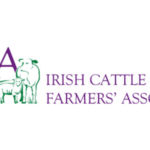Farmers buying heifers and cows can now look up the predicted replacement breeding values for animals located in herds participating in BDGP or HerdPlus.
Decisions on purchasing heifers and cows may now have the potential to take into account the animal’s €urostar replacement index (and EBI for dairy animals) and predicted performance. This follows the recent launch of the extended Irish Cattle Breeding Federation (ICBF) animal search facility which is located at www.icbf.com
Speaking at last Friday’s Irish Cattle & Sheep Farmer Association’s (ICSA) field event held on Jim Cosgrave’s farm in Enfield, county Meath, ICBF’s Stephen Conroy said that the facility will be familiar to anyone who has previously used the ‘bull search’ facility.

A cross-section of some of the crowd at the event.
The process is exactly the same with the tag number (or name for pedigree animals) entered into the search facility. The only limitation to the search facility is that at the moment only €urostar evaluations for animals located in herds participating in the Beef Data and Genomics Programme and HerdPlus will be shown.
Expected performance
As shown here, the €urostar index gives information on an animal’s date of birth and sire/dam breed make-up where known. This in turn gives an assessment of an animal’s replacement index value with a detailed breakdown on expected performance of progeny including calving difficulty, docility, carcase weight and carcase conformation, along with expected daughter breeding performance including daughter calving ability, daughter milk yield and daughter calving interval.
Stephen Conroy said the facility is a breakthrough in allowing farmers access the best genetics available. “Farmers looking at heifers or cows in a mart or on a farm can now potentially have breeding information at the finger tips. Sellers can also use it to promote their animals breeding qualities. It is available at present for animals in herds participating in BDGP and HerdPlus and this is a big step forward for the industry. Analysis carried out by ICBF shows that on average cows with a five star replacement index leave €284 more profit than cows rated as one star on the replacement index. This comes through better longevity, heavier calves at weaning, heifers being able to calve younger and achieve a shorter calving interval, producing more calves and progeny that will be slaughtered at a younger age”. A detailed breakdown of the analysis is shown in the story’s photos.
Updated throughout the year
Conroy also advised farmers looking at the breeding values of females or males to take note that indexes are updated three times a year in April, August and December.
“We frequently get calls from farmers and breeders wondering why their bulls or heifers breeding values have changed. This is due to more information coming available on the animal. This can be on the animal’s own performance, their progeny or performance of their siblings, relations or even changes in ancestry.
“We realise this can be frustrating at times but the benefit is that the more information collected by farmers, the better the accuracy and reliability will be of an animal’s predicted performance. Genomics will also have a large role to play in predicted breeding performance with greater accuracy”, said Conroy.







